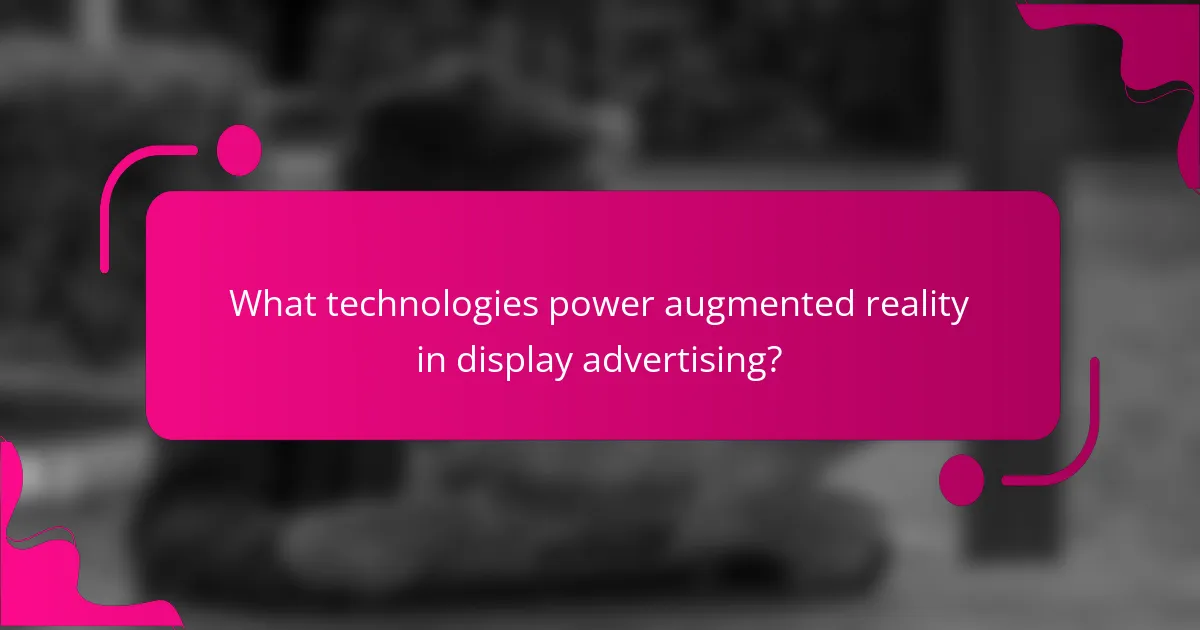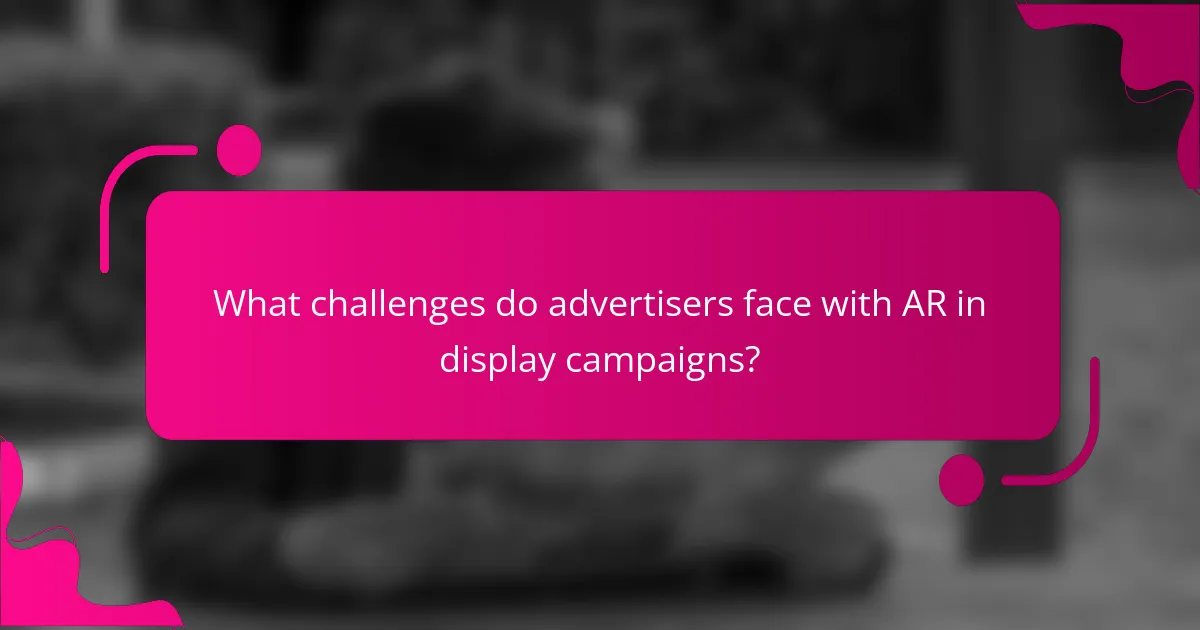Augmented reality (AR) is transforming display campaigns by creating immersive experiences that captivate consumers and encourage interaction. By leveraging AR technology, brands can present engaging content that allows users to visualize products in their own environments, resulting in increased engagement and higher conversion rates.

How can augmented reality enhance display campaigns in the UK?
Augmented reality (AR) can significantly enhance display campaigns in the UK by creating immersive experiences that capture consumer attention and drive interaction. By integrating AR technology, brands can offer engaging content that allows users to visualize products in real-world settings, leading to higher engagement and conversion rates.
Increased user engagement
AR enhances user engagement by providing interactive content that encourages active participation. For instance, users can try on virtual clothing or visualize furniture in their homes, making the experience more personal and memorable. This level of interactivity can lead to longer time spent on ads and increased likelihood of sharing content.
To maximize engagement, brands should ensure that AR experiences are easy to access and use. Simple QR codes or app integrations can facilitate quick access, reducing barriers for users. Additionally, incorporating gamification elements can further boost engagement by making the experience fun and rewarding.
Improved brand recall
Utilizing AR in display campaigns can significantly improve brand recall among consumers. When users interact with AR content, they are more likely to remember the brand associated with that experience. Studies suggest that interactive and visual content can enhance memory retention compared to traditional static ads.
To leverage this potential, brands should focus on creating unique and memorable AR experiences that align with their identity. Consistent branding elements, such as logos and color schemes, should be integrated into the AR content to reinforce brand recognition and recall.
Interactive experiences
AR allows brands to create interactive experiences that go beyond traditional advertising. For example, users can engage with 3D models of products, participate in virtual events, or explore interactive storytelling. These experiences not only entertain but also educate consumers about the product features and benefits.
When designing interactive AR experiences, brands should prioritize user-friendliness and accessibility. Clear instructions and intuitive interfaces can help ensure that users can easily navigate the experience. Additionally, collecting user feedback can provide insights for future improvements and enhance overall satisfaction.

What technologies power augmented reality in display advertising?
Augmented reality (AR) in display advertising is powered by various technologies that enhance user engagement through immersive experiences. Key technologies include AR SDKs, WebAR solutions, and 3D modeling software, each contributing uniquely to the development and deployment of AR campaigns.
AR SDKs like ARKit and ARCore
AR SDKs, such as Apple’s ARKit and Google’s ARCore, provide developers with the tools to create AR experiences on mobile devices. These frameworks enable the integration of virtual content with the real world by utilizing device sensors and cameras for tracking and rendering.
When choosing an AR SDK, consider factors like platform compatibility, ease of use, and community support. For instance, ARKit is optimized for iOS devices, while ARCore is tailored for Android, making them essential for targeting specific user bases.
WebAR solutions
WebAR solutions allow users to access AR experiences directly through web browsers without needing to download an app. This technology leverages WebGL and WebRTC to deliver interactive content seamlessly across devices.
Implementing WebAR can significantly lower barriers to entry for users, as it requires no installation. However, performance may vary based on the browser and device capabilities, so testing across multiple platforms is crucial for optimal user experience.
3D modeling software
3D modeling software is essential for creating the virtual objects that populate AR experiences. Tools like Blender, Maya, and SketchUp enable designers to craft detailed 3D models that can be integrated into AR applications.
When selecting 3D modeling software, consider the complexity of the models you need and the software’s compatibility with your chosen AR SDK. High-quality models can enhance user engagement, but they should be optimized for performance to ensure smooth interactions in AR environments.

What are the best practices for implementing AR in display campaigns?
To effectively implement augmented reality (AR) in display campaigns, focus on user engagement, seamless technology integration, and future scalability. Prioritizing clear communication and technical efficiency will enhance user experience and drive better results.
Clear user instructions
Providing clear user instructions is essential for successful AR implementation in display campaigns. Users should easily understand how to interact with the AR features, which can be achieved through concise prompts or tutorials. For example, using visual cues or short videos can guide users through the experience.
Consider placing instructions prominently within the AR interface. This ensures that users can quickly access guidance without feeling overwhelmed or confused. Avoid jargon and keep language simple to cater to a broad audience.
Optimized loading times
Optimizing loading times is crucial for maintaining user engagement in AR campaigns. Slow loading can lead to frustration and increased bounce rates. Aim for loading times under a few seconds to keep users interested and engaged with the content.
To achieve this, compress images and use efficient coding practices. Testing on various devices can help identify bottlenecks and ensure a smooth experience across platforms. Regularly monitor performance metrics to make necessary adjustments.
Mobile-friendly design
Designing AR experiences with mobile users in mind is vital, as a significant portion of AR interactions occur on smartphones. Ensure that the interface is responsive and intuitive, adapting seamlessly to different screen sizes and orientations.
Utilize touch-friendly elements and avoid overly complex interactions that may frustrate users. Testing the AR experience on multiple mobile devices will help identify usability issues, ensuring that all users can enjoy the campaign without technical barriers.

What are the key metrics for measuring AR campaign success?
Key metrics for measuring augmented reality (AR) campaign success include engagement rates, conversion rates, and time spent interacting with the AR content. These metrics provide valuable insights into how effectively the AR experience resonates with users and drives desired actions.
Engagement rates
Engagement rates indicate how actively users interact with AR content. This can be measured through metrics such as clicks, shares, and interactions with AR elements. A high engagement rate often suggests that the AR experience is capturing users’ attention and encouraging them to explore further.
To improve engagement rates, consider incorporating interactive features like quizzes or gamified elements. Tracking engagement through analytics tools can help identify which aspects of the AR experience are most appealing to users.
Conversion rates
Conversion rates measure the percentage of users who take a desired action after interacting with AR content, such as making a purchase or signing up for a newsletter. A successful AR campaign should aim for a conversion rate that reflects a significant increase compared to traditional marketing methods.
To boost conversion rates, ensure that the AR experience seamlessly integrates with the purchasing process. Clear calls to action and easy navigation can help guide users toward completing their desired actions.
Time spent interacting
Time spent interacting with AR content is a crucial metric that reflects user interest and engagement depth. Longer interaction times often indicate that users find the experience valuable and are willing to invest time in it. This metric can vary widely depending on the complexity of the AR experience.
To maximize interaction time, create immersive and informative AR experiences that encourage exploration. Regularly analyze user behavior to identify which elements keep users engaged and adjust your content accordingly.

What challenges do advertisers face with AR in display campaigns?
Advertisers encounter several challenges when integrating augmented reality (AR) into display campaigns, including technical limitations, user adoption barriers, and high development costs. These factors can hinder the effectiveness and reach of AR initiatives, making it essential for marketers to navigate these obstacles carefully.
Technical limitations
Technical limitations in AR can affect the user experience and the overall effectiveness of display campaigns. Issues such as device compatibility, processing power, and internet connectivity can restrict how well AR content performs across different platforms. For instance, older smartphones may struggle to render AR experiences smoothly, leading to frustration for users.
Additionally, the quality of AR experiences can vary significantly based on the technology used. Advertisers should ensure that their AR content is optimized for a range of devices to maximize engagement. Testing on multiple platforms before launch can help identify potential issues.
User adoption barriers
User adoption barriers are significant challenges for AR in display campaigns. Many consumers may be unfamiliar with AR technology, leading to hesitation in engaging with AR content. Marketers must educate their audience about the benefits and ease of use of AR experiences to encourage participation.
Moreover, privacy concerns can deter users from engaging with AR campaigns. Advertisers should be transparent about data usage and ensure compliance with regulations such as GDPR to build trust and encourage user participation.
High development costs
High development costs are a critical factor that can limit the implementation of AR in display campaigns. Creating high-quality AR experiences often requires specialized skills and technology, which can lead to significant expenses. Budgeting for AR initiatives should account for design, development, and testing phases to avoid overspending.
To mitigate costs, advertisers can consider partnering with AR development firms or utilizing existing AR platforms that offer templates and tools. This approach can reduce the time and resources needed to create effective AR content while still delivering engaging experiences to users.

How does augmented reality compare to traditional display advertising?
Augmented reality (AR) enhances traditional display advertising by creating interactive and immersive experiences that engage users more deeply. Unlike static ads, AR allows consumers to visualize products in their environment, leading to higher engagement and conversion rates.
Engagement Levels
Engagement levels in augmented reality campaigns tend to be significantly higher than in traditional display ads. Users can interact with products in real-time, which fosters a sense of connection and interest. For example, AR applications enable customers to try on clothes or visualize furniture in their homes, making the experience more personal and memorable.
Technology Requirements
Implementing augmented reality in display advertising requires specific technology, including AR software and compatible devices such as smartphones or AR glasses. Brands must invest in developing AR content, which can range from simple 3D models to complex interactive experiences. Additionally, ensuring compatibility across various platforms is crucial for maximizing reach.
Future Potential
The future potential of augmented reality in display advertising is vast, with trends indicating an increasing adoption of AR technologies. As hardware becomes more accessible and affordable, more brands are likely to integrate AR into their marketing strategies. This could lead to innovative advertising formats that further blur the lines between the digital and physical worlds, creating richer consumer experiences.
